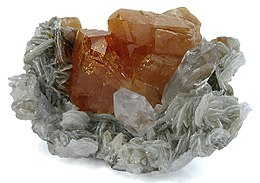
Back Scheeliet AF Шэеліт BE Шеелит Bulgarian Scheelita Catalan Scheelit Czech Scheelit German Σεελίτης Greek Scheelito EO Scheelita Spanish Scheelita EU
| Scheelite | |
|---|---|
 | |
| General | |
| Category | Tungstate mineral |
| Formula (repeating unit) | CaWO4 |
| IMA symbol | Sch[1] |
| Strunz classification | 7.GA.05 |
| Crystal system | Tetragonal |
| Crystal class | Dipyramidal (4/m) H-M symbol: (4/m) |
| Space group | I41/a |
| Unit cell | a = 5.2429(3), Å c = 11.3737(6) Å; Z = 4 |
| Identification | |
| Color | Colorless, white, gray, dark brown, brown, tan, pale yellow, yellow-orange, golden yellow, pale shades of orange, red, green, etc.; colorless in transmitted light and may be compositionally color zoned |
| Crystal habit | Pseudo-octahedra, massive, columnar, granular |
| Twinning | Common, penetration and contact twins, composition plane {110} or {001} |
| Cleavage | On {101}, distinct; on {112}, interrupted; on {001}, indistinct |
| Fracture | Subconchoidal to uneven |
| Tenacity | Brittle |
| Mohs scale hardness | 4.5–5 |
| Luster | Vitreous to adamantine |
| Streak | White |
| Diaphaneity | Transparent to opaque |
| Specific gravity | 5.9–6.1 |
| Optical properties | Uniaxial (+) |
| Refractive index | nω = 1.918–1.921, nε = 1.935–1.938 |
| Birefringence | δ = 0.017 |
| Pleochroism | Definite dichoric in yellow (yellow to orange-brown) |
| Fusibility | With difficulty |
| Solubility | Soluble in alkalis. Insoluble in acids |
| Other characteristics | Fluorescence under short-wave UV is bright blue, bluish white to yellow. Specimens with more molybdenum tend to fluoresce white to yellow, similar to powellite. Occasionally fluoresces red under mid-wave UV. |
| References | [2][3][4][5] |
Scheelite is a calcium tungstate mineral with the chemical formula CaWO4. It is an important ore of tungsten (wolfram). Scheelite is originally named after Swedish chemist Carl Wilhelm Scheele (1742–1786). Well-formed crystals are sought by collectors and are occasionally fashioned into gemstones when suitably free of flaws. Scheelite has been synthesized using the Czochralski process; the material produced may be used to imitate diamond, as a scintillator, or as a solid-state lasing medium. It was also used in radium paint in the same fashion as was zinc sulphide, and Thomas Edison invented a fluoroscope with a calcium tungstate-coated screen, making the images six times brighter than those with barium platinocyanide; the latter chemical allowed Röntgen to discover X-rays in early November 1895. Note, the semi-precious stone marketed as 'blue scheelite' is actually a rock type consisting mostly of calcite and dolomite, with occasional traces of yellow-orange scheelite.
- ^ Warr, L.N. (2021). "IMA–CNMNC approved mineral symbols". Mineralogical Magazine. 85 (3): 291–320. Bibcode:2021MinM...85..291W. doi:10.1180/mgm.2021.43. S2CID 235729616.
- ^ http://rruff.geo.arizona.edu/doclib/hom/scheelite.pdf Handbook of Mineralogy
- ^ http://www.mindat.org/min-3560.html Mindat.org
- ^ http://webmineral.com/data/Scheelite.shtml Webmineral data
- ^ Klein, Cornelis and Cornelius S. Hurlbut, Manual of Mineralogy, Wiley, 20th ed., 1985, p. 356 ISBN 0-471-80580-7.